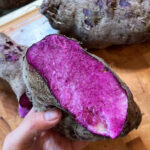Annatto oil, also known for its many names as achuete or achiote oil, is an essential ingredient in many Asian and Latin dishes. Made by gently infusing oil with annatto seeds, this oil provides a subtle peppery and earthy taste to dishes while giving them a pop of color.

Annatto is a staple in many Filipino dishes, mainly as a coloring agent to give foods a red/orange hue. It’s an all-natural food coloring which you can use for not only Filipino food, but also for any noodles, soups, stews, or even stir-fries that you think may need a pop of color!
Taste-wise, annatto is fairly fragrant and mild. The intensity and flavor of the seeds can be further extracted when gently simmered in hot oil.

For my annatto oil, I like to simmer it with a mixture of aromatics to further compliment and enhance the natural flavor of the seeds. It’s optional, but I really do think that extra bit of work and love is a key step to making an excellent annatto oil -especially when it’s going to be a huge component in a dish.
What is Annatto?
Annatto has many different names. In the Philippines, we call it “Atsuete” or “Achuete”. It can also be called achiote, all depending on your language of origin.
The seeds itself comes from the Achiote tree, native to the tropical areas of central and South America. As a result, you can find this ingredient as an essential component in many Latin and Asian dishes.

Annatto by itself doesn’t taste like anything much. It’s very, very subtle -unless, of course, you added tons of it into a recipe.
Slightly peppery, nutty, and somewhat sweet, the annatto imparts food with not only a mild flavor, but also with a beautiful crimson red color.

Ingredients
Annatto seeds: You can purchase annatto seeds either in bulk or in tiny packets, typically found in most Filipino groceries. You could also try poking around in larger Asian or Latin markets if they carry it as well.

Neutral oil: Any neutral oil with a high smoke point can work for this recipe. Oils like corn, canola, peanut, vegetable, or soy bean are perfect. I try to stay away from olive oils since their aroma and flavors tend to be stronger, which can overpower the natural flavor of the annatto seeds.
Garlic, bay leaves, red onion: Three of the most common aromatics typically used in Filipino cooking to enhance the flavor of our annatto oil.
Instructions
In a cold pot, combine together the neutral oil, annatto seeds, garlic, bay leaves, and red onion. Bring the oil to heat over medium.

Once heated, look for the bubbles that begin to form around the seeds and aromatics. Maintain this heat over medium and let simmer for 10 minutes. If the bubbling becomes too vigorous and the things are starting to brown too quickly, lower the heat to avoid burning.
After 10 minutes of a gentle simmer, remove the pot from the heat and let the oil cool completely, letting the seeds and aromatics steep for an additional 15-30 minutes.

Once cool, strain the oil into a container for storage and future use.

Tips for making annatto oil
- The more annatto seeds you use, the more intense the color and flavor. I like my oil to annatto seed ratio to be a 1 : 0.25, meaning that for every cup of oil, you would use 1/4 cup of seeds. It’s a nice ratio where you get just enough seeds to infuse the oil with its flavor, but also just enough to give it a vibrant ruby color. I personally find that adding too many seeds makes the oil too bitter and the color becomes overly dark.
- Control the oil’s temperature. Too hot of an oil, and you risk burning the seeds and aromatics, leading to a bitter, burnt-tasting oil. Too cold of an oil, and the lack of heat prevents proper extraction of the seeds and aromatics, causing a bland annatto oil.
- Annatto oil stains. I learned this the hard way. While testing out this recipe I poured a large batch of annatto oil into multiple Tupperwares and deli containers and let them sit. Lo and behold, the oil stained all of them -even with vigorous scrubbing! If you’re wary about staining, just be mindful that the oil has a tendency to stain very porous materials like wooden spoons and even kitchen towels.
FAQs
Can I use annatto powder for this recipe?
You can! While I don’t have exact measurements for this (currently un-tested), I’d recommend to use less powder than seeds if you’re going to follow this recipe. Annatto powder has greater surface area, allowing it to infuse and color the oil much quicker than in seed form.
Be advised that annatto powder is notorious for clumping and being gritty, so ensure that you adequately whisk the powder into the oil to avoid those mistakes.
Can I add more aromatics into my annatto oil?
Yes, you definitely can. While I ended up using garlic, bay leaves, and red onions for this recipe, I’d imagine adding lemongrass, ginger, or even a couple handfuls of whole peppercorns would take this annatto oil to the next level. That being said, you an also simplify the recipe by omitting the aromatics altogether.
What recipes can I use annatto in?
One of my favorite uses of annatto oil is in my Chicken Inasal recipe -one of the most popular recipes on our website!
The annatto oil is a key component in the marinade and the basting sauce, which is perfect for oven roasting or for outdoor barbecues.

Other general uses of annatto powder can be found in classic Filipino dishes such as Pancit Palabok, Pork Tocino, Longganisa, and Kwek Kwek!

Craving for more delicious and tasty recipes? Here’s a few you might enjoy:
Disclosure: Some links on this page are affiliate links, meaning that at no additional cost to you, we may receive compensation from purchases made through these links. As an Amazon Associate, I can earn from qualifying purchases.







